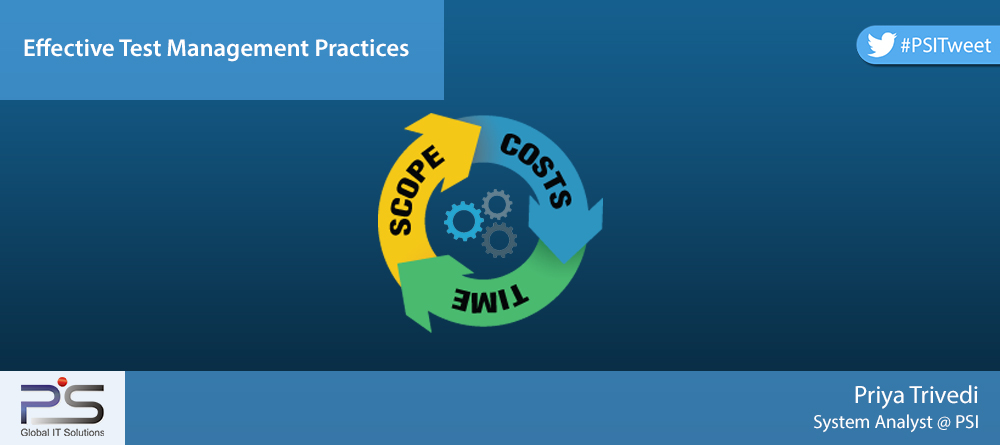Software testing is a vital part of software development life cycle, to ensure the developed program is bug-free, consistently meeting and exceeding the customer expectations in terms of quality. This can be achieved by a well-managed test life-cycle supported by some excellent engineers.
An effective test management system requires pre-defined procedures and processes in place. All well-organized processes are predictable and repeatable are usually more supportive to estimate and plan your testing activities.
An organization may face challenges while implementing and following test life cycle like:
- Not enough time to test products due to tight deadlines,
- Lack of resources with better opportunities cropping up everywhere,
- Distributed testing team,
- Frequent changes in requirements,
- Delay in development or client has not shared the required information
To overcome these challenges and increase ROI, an organization should follow following well-known practices for an effective test management system.
- Initiate testing activities early on in software development life cycle as early bug identification which will help to reduced cost to fix the issues
- Few test scenarios/test cases can be identified or extracted from the initial software requirements analysis phase,
- Implementation of iterative tests helps to generate important testing aspects along with early bug detection
- Apply test management skills to foresee certain assets like possible test procedures, test scenarios, test automation scripts or objects etc. which can be reused to save time and efforts and help to enhance the quality and efficiency of a product.
- To test new aspects of a project like agile, security, big data, analytics, mobile testing etc., testing team needs to follow different testing approaches like requirement based testing approaches that can help in system/application validation and calculate the testing efforts as well.
- Well, informed, proper coordination and effective communication is a key to reducing resource issues, improve project timeline, maximize productivity and therefore increase organization’s ROI.
For a successful test management implementation, it is important to define customizable workflow & enforce flexible testing processes which can be repeatable and also allow for further optimization and modifications based on requirements because different projects have different testing needs and different testing efforts.
To deliver a quality product, development and testing team needs to work in a complete tandem with each other. This inseparable teamwork improves quality, reduces any communication issues, seamless integration of test environment and aids to for any missed details.
Plan for a good test management tool, commercial or open sourced available in the market to reduce time and efforts. Few tools need to be installed in-house whereas others can be accessed as Software as a Service (SaaS). Such few tools examples are IBM Rational Quality Manager, Silk Central, JIRA, Zephyr, HP Quality Centre, QA Complete etc.
As the testing team plays a very crucial role in the success of an organization progress, hence manage the testing team prudently and insightfully.Software testing is a vital part of software development life cycle, to ensure the developed program is bug-free, consistently meeting and exceeding the customer expectations in terms of quality. This can be achieved by a well-managed test life-cycle supported by some excellent engineers.
An effective test management system requires pre-defined procedures and processes in place. All well-organized processes are predictable and repeatable are usually more supportive to estimate and plan your testing activities.
An organization may face challenges while implementing and following test life cycle like:
- Not enough time to test products due to tight deadlines,
- Lack of resources with better opportunities cropping up everywhere,
- Distributed testing team,
- Frequent changes in requirements,
- Delay in development or client has not shared the required information
To overcome these challenges and increase ROI, an organization should follow following well-known practices for an effective test management system.
- Initiate testing activities early on in software development life cycle as early bug identification which will help to reduced cost to fix the issues
- Few test scenarios/test cases can be identified or extracted from the initial software requirements analysis phase,
- Implementation of iterative tests helps to generate important testing aspects along with early bug detection
- Apply test management skills to foresee certain assets like possible test procedures, test scenarios, test automation scripts or objects etc. which can be reused to save time and efforts and help to enhance the quality and efficiency of a product.
- To test new aspects of a project like agile, security, big data, analytics, mobile testing etc., testing team needs to follow different testing approaches like requirement based testing approaches that can help in system/application validation and calculate the testing efforts as well.
- Well, informed, proper coordination and effective communication is a key to reducing resource issues, improve project timeline, maximize productivity and therefore increase organization’s ROI.
For a successful test management implementation, it is important to define customizable workflow & enforce flexible testing processes which can be repeatable and also allow for further optimization and modifications based on requirements because different projects have different testing needs and different testing efforts.
To deliver a quality product, development and testing team needs to work in a complete tandem with each other. This inseparable teamwork improves quality, reduces any communication issues, seamless integration of test environment and aids to for any missed details.
Plan for a good test management tool, commercial or open sourced available in the market to reduce time and efforts. Few tools need to be installed in-house whereas others can be accessed as Software as a Service (SaaS). Such few tools examples are IBM Rational Quality Manager, Silk Central, JIRA, Zephyr, HP Quality Centre, QA Complete etc.
As the testing team plays a very crucial role in the success of an organization progress, hence manage the testing team prudently and insightfully.[:]









